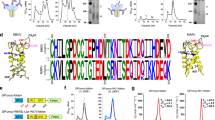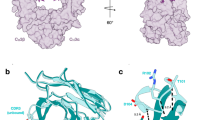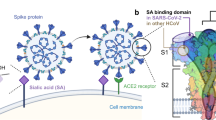Abstract
The use of multivalent carbohydrate compounds to block cell-surface lectin receptors is a promising strategy to inhibit the entry of pathogens into cells and could lead to the discovery of novel antiviral agents. One of the main problems with this approach, however, is that it is difficult to make compounds of an adequate size and multivalency to mimic natural systems such as viruses. Hexakis adducts of [60]fullerene are useful building blocks in this regard because they maintain a globular shape at the same time as allowing control over the size and multivalency. Here we report water-soluble tridecafullerenes decorated with 120 peripheral carbohydrate subunits, so-called ‘superballs’, that can be synthesized efficiently from hexakis adducts of [60]fullerene in one step by using copper-catalysed azide–alkyne cycloaddition click chemistry. Infection assays show that these superballs are potent inhibitors of cell infection by an artificial Ebola virus with half-maximum inhibitory concentrations in the subnanomolar range.
This is a preview of subscription content, access via your institution
Access options
Subscribe to this journal
Receive 12 print issues and online access
$259.00 per year
only $21.58 per issue
Buy this article
- Purchase on Springer Link
- Instant access to full article PDF
Prices may be subject to local taxes which are calculated during checkout



Similar content being viewed by others
References
Mammen, M., Choi, S.-K. & Whitesides, G. M. Polyvalent interactions in biological systems: implications for design and use of multivalent ligands and inhibitors. Angew. Chem. Int. Ed. 37, 2754–2794 (1998).
Guo, Y. et al. Structural basis for distinct ligand-binding and targeting properties of the receptors DC-SIGN and DC-SIGNR. Nature Struct. Mol. Biol. 11, 591–598 (2004).
Imperiali, B. The chemistry–glycobiology frontier. J. Am. Chem. Soc. 134, 17835–17839 (2012).
Fasting, C. et al. Multivalency as a chemical organization and action principle. Angew. Chem. Int. Ed. 51, 10472–10498 (2012).
Imberty, A., Chabre, Y. M. & Roy, R. Glycomimetics and glycodendrimers as high affinity microbial anti-adhesins. Chem. Eur. J. 14, 7490–7499 (2008).
Roy, R. A decade of glycodendrimer chemistry. Trends Glycosci. Glycotechnol. 15, 291–310 (2003).
Roy, R. & Baek, M.-G. Glycodendrimers: novel glycotope isosteres unmasking sugar coding. Case study with T-antigen markers from breast cancer MUC1 glycoprotein. Rev. Mol. Biotechnol. 90, 291–309 (2002).
Chabre, Y. M. & Roy, R. in Advances in Carbohydrate Chemistry and Biochemistry Vol. 63 (ed. Derek, H.) 165–393 (Academic Press, 2010).
Cecioni, S., Imberty, A. & Vidal, S. Glycomimetics versus multivalent glycoconjugates for the design of high affinity lectin ligands. Chem. Rev. 115, 525–561 (2015).
Hirsch, A. & Vostrowsky, O. C60 hexakisadducts with an octahedral addition pattern—a new structure motif in organic chemistry. Eur. J. Org. Chem. 2001, 829–848 (2001).
Lamparth, I., Maichle–Mössmer, C. & Hirsch, A. Reversible template-directed activation of equatorial double bonds of the fullerene framework: regioselective direct synthesis, crystal structure, and aromatic properties of Th-C66(COOEt)12 . Angew. Chem. Int. Ed. Engl. 34, 1607–1609 (1995).
Hirsch, A. in Fullerenes and Related Structures (ed. Hirsch, A.) 1–65 (Topics in Current Chemistry 199, Springer, 1999).
Iehl, J., Pereira de Freitas, R., Delavaux-Nicot, B. & Nierengarten, J.-F. Click chemistry for the efficient preparation of functionalized [60]fullerene hexakis-adducts. Chem. Commun. 2450–2452 (2008).
Nierengarten, J.-F. et al. Fullerene sugar balls. Chem. Commun. 46, 3860–3862 (2010).
Sánchez-Navarro, M., Muñoz, A., Illescas, B. M., Rojo, J. & Martín, N. [60]Fullerene as multivalent scaffold efficient molecular recognition of globular glycofullerenes by concanavalin A. Chem. Eur. J. 17, 766–769 (2011).
Rísquez-Cuadro, R., García Fernández, J. M., Nierengarten, J.-F. & Ortiz Mellet, C. Fullerene-sp2-iminosugar balls as multimodal ligands for lectins and glycosidases: a mechanistic hypothesis for the inhibitory multivalent effect. Chem. Eur. J. 19, 16791–16803 (2013).
Cecioni, S. et al. Synthesis of dodecavalent fullerene-based glycoclusters and evaluation of their binding properties towards a bacterial lectin. Chem. Eur. J. 17, 3252–3261 (2011).
Nierengarten, I. & Nierengarten, J.-F. Fullerene sugar balls: a new class of biologically active fullerene derivatives. Chem. Asian J. 9, 1436–1444 (2014).
Durka, M. et al. The functional valency of dodecamannosylated fullerenes with Escherichia coli FimH-towards novel bacterial antiadhesives. Chem. Commun. 47, 1321–1323 (2011).
Luczkowiak, J. et al. Glycofullerenes inhibit viral infection. Biomacromolecules 14, 431–437 (2013).
Hörmann, F. & Hirsch, A. Giant fullerene polyelectrolytes composed of C60 building blocks with an octahedral addition pattern and discovery of a new cyclopropanation reaction involving dibromomalonates. Chem. Eur. J. 19, 3188–3197 (2013).
Wasserthal, L. K., Kratzer, A. & Hirsch, A. Sequential fullerenylation of bis-malonates—efficient access to oligoclusters with different fullerene building blocks. Eur. J. Org. Chem. 2013, 2355–2361 (2013).
Balbinot, D. et al. Electrostatic assemblies of fullerene−porphyrin hybrids: toward long-lived charge separation. J. Phys. Chem. B 107, 13273–13279 (2003).
Wessendorf, F. et al. Implementation of a Hamilton-receptor-based hydrogen-bonding motif toward a new electron donor−acceptor prototype: electron versus energy transfer. J. Am. Chem. Soc. 129, 16057–16071 (2007).
Durka, M. et al. The inhibition of liposaccharide heptosyltransferase WaaC with multivalent glycosylated fullerenes: a new mode of glycosyltransferase inhibition. Chem. Eur. J. 18, 641–651 (2012).
Ciampi, S. et al. Functionalization of acetylene-terminated monolayers on Si(100) surfaces: a click chemistry approach. Langmuir 23, 9320–9329 (2007).
Collman, J. P., Devaraj, N. K., Eberspacher, T. P. A. & Chidsey, C. E. D. Mixed azide-terminated monolayers: a platform for modifying electrode surfaces. Langmuir 22, 2457–2464 (2006).
Devaraj, N. K., Decreau, R. A., Ebina, W., Collman, J. P. & Chidsey, C. E. D. Rate of interfacial electron transfer through the 1,2,3-triazole linkage. J. Phys. Chem. B 110, 15955–15962 (2006).
Alvarez, C. P. et al. C-type lectins DC-SIGN and L-SIGN mediate cellular entry by Ebola virus in cis and in trans. J. Virol. 76, 6841–6844 (2002).
Kondratowicz, A. S. et al. T-cell immunoglobulin and mucin domain 1 (TIM-1) is a receptor for Zaire Ebolavirus and Lake Victoria Marburgvirus. Proc. Natl Acad. Sci. USA 108, 8426–8431 (2011).
Carette, J. E. et al. Ebola virus entry requires the cholesterol transporter Niemann–Pick C1. Nature 477, 340–343 (2011).
Ribeiro-Viana, R. et al. Virus-like glycodendrinanoparticles displaying quasi-equivalent nested polyvalency upon glycoprotein platforms potently block viral infection. Nature Commun. 3, 1303 (2012).
Yang, S. L. et al. Generation of retroviral vector for clinical studies using transient transfection. Hum. Gene Ther. 10, 123–132 (1999).
Connor, R. I., Chen, B. K., Choe, S. & Landau, N. R. Vpr is required for efficient replication of Human-Immuno-Deficiency-Virus Type-1 in mononuclear phagocytes. Virology 206, 935–944 (1995).
Luczkowiak, J. et al. Pseudosaccharide functionalized dendrimers as potent inhibitors of DC-SIGN dependent Ebola pseudotyped viral infection. Bioconjugate Chem. 22, 1354–1365 (2011).
Lasala, F., Arce, E., Otero, J. R., Rojo, J. & Delgado, R. Mannosyl glycodendritic structure inhibits DC-SIGN-mediated Ebola virus infection in cis and in trans. Antimicrob. Agents Chemother. 47, 3970–3972 (2003).
Acknowledgements
Financial support by the European Research Council (ERC-2012-ADG_320441 (Chirallcarbon), ITN-2008-213592 (CARMUSYS)), Ministerio de Economía y Competitividad (MINECO) of Spain (projects CTQ2014-52045-R, CTQ2011-23410 and CTQ2012-31914), the Comunidad Autónoma de Madrid (PHOTOCARBON project S2013/MIT-2841), Instituto de Salud Carlos III (ISCIII) (FIS PI1101580 and FIS1400708), the Agence National de la Recherche (ANR, Programme Blanc 2011), the International Center for Frontier Research in Chemistry and LabEx ‘Chimie des Systèmes Complexes’ is acknowledged. N.M. thanks the Alexander von Humboldt Foundation. S.P.V. and K.B. thank FNRS (FRIA fellowship).
Author information
Authors and Affiliations
Contributions
A.M., D.S., I.N., M.H. and K.B. carried out the synthesis and characterization of all the new derivatives. L.R.-P. and J.-S.R. realized and analysed the DLS and TEM. L.R.-P. realized the XPS analyses and contributed to the writing of the paper. J.L. and R.D. realized the biological and cytotoxicity studies. B.M.I., S.P.V., J.R., R.D., J.-F.N. and N.M. designed the project, supervised the work, discussed the data and wrote the manuscript.
Corresponding authors
Ethics declarations
Competing interests
The authors declare no competing financial interests.
Supplementary information
Supplementary information
Supplementary information (PDF 4365 kb)
Rights and permissions
About this article
Cite this article
Muñoz, A., Sigwalt, D., Illescas, B. et al. Synthesis of giant globular multivalent glycofullerenes as potent inhibitors in a model of Ebola virus infection. Nature Chem 8, 50–57 (2016). https://doi.org/10.1038/nchem.2387
Received:
Accepted:
Published:
Issue Date:
DOI: https://doi.org/10.1038/nchem.2387
This article is cited by
-
Chemistry of difluoromethylenefullerenes
Russian Chemical Bulletin (2023)
-
Inhibitory effect and mechanism of gelatin stabilized ferrous sulfide nanoparticles on porcine reproductive and respiratory syndrome virus
Journal of Nanobiotechnology (2022)
-
A three-shell supramolecular complex enables the symmetry-mismatched chemo- and regioselective bis-functionalization of C60
Nature Chemistry (2021)
-
Visible-light triggered photochemical reaction for the synthesis of dumbbell-like bis aminomethyl-1, 2 dihydrofullerene dimers via addition of α-amino radicals
Research on Chemical Intermediates (2021)
-
Atomically defined angstrom-scale all-carbon junctions
Nature Communications (2019)






